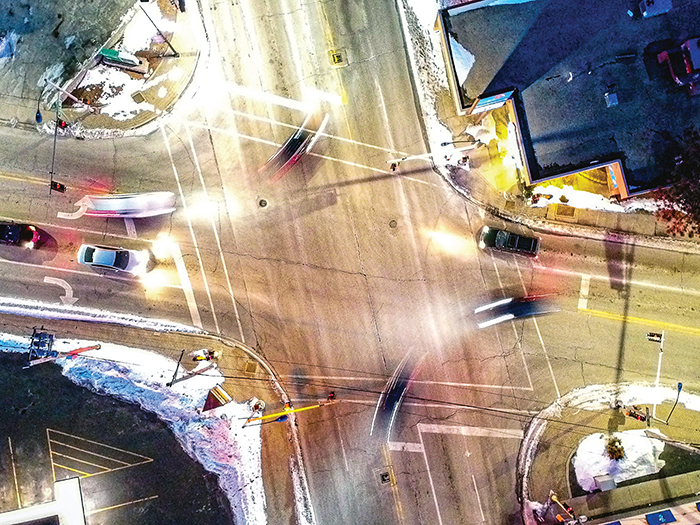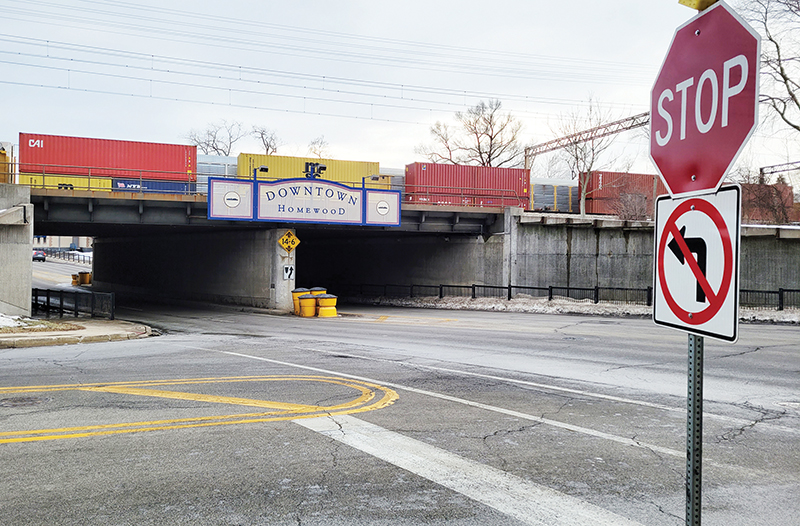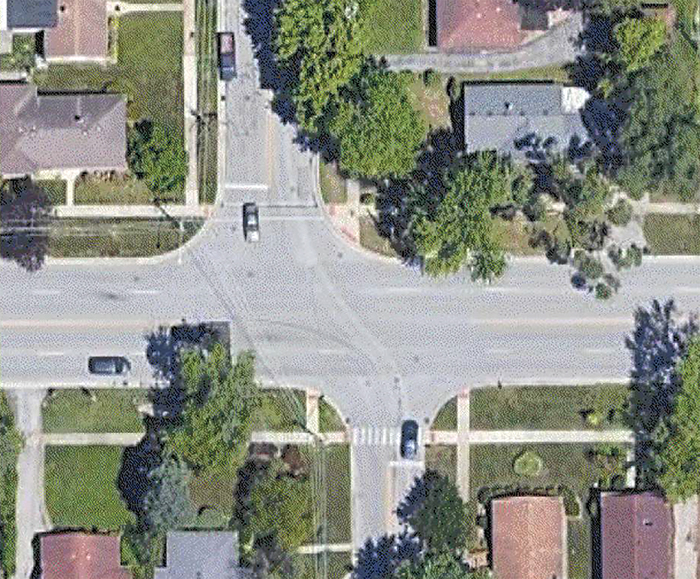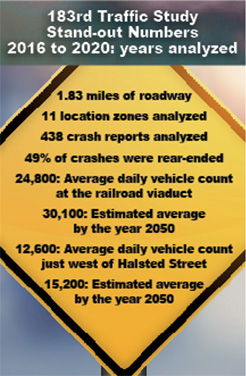Let’s head west on 183rd Street, starting at Halsted Street. A car might be returning home from a shopping trip to Target. Maybe it just exited the expressway. It could be a driver avoiding the tollway between work and home.
Now the drivers are on 183rd, cruising down a corridor lined with closely packed driveways and side streets. The speed limit is 30 miles per hour, but most regulars and residents know drivers there often go much faster.
On bad days, these road conditions lead to crashes, many with serious injuries. In the past five years, two people lost their lives as a result of vehicle crashes on 183rd Street.
After the most recent death in summer 2020, Homewood village officials responded to residents’ outcry over what they say are unsafe driving conditions on 183rd by commissioning a traffic study.
The result is the first comprehensive look at how many vehicles travel the road, the conditions drivers encounter, crashes that took place and how the village can adjust the environment to modify driver behavior and ultimately make 183rd Street a safer road to travel.

Heading west from Halsted Street
We’re back on the road with our cars headed westbound on 183rd Street from Halsted. Despite coming from such a busy intersection, they’re actually in an area less prone to crashes. The study examined a 1.83-mile stretch of 183rd from Halsted to Park Avenue, dividing it into 11 zones for analysis.
“I think the perception is that there are more accidents from Center to Halsted,” said Homewood Public Works Director John Schaefer. “What the study showed is that there are more accidents from Riegel to Dixie.”
Whether you’re at one end or the other, the speed limit on 183rd is 30 mph through nearly all of Homewood, and Village Manager Napoleon Haney said the village has started a special police detail to specifically patrol for speeders.

After numerous resident complaints, Haney said village officials worked with Homewood Police Chief Denise McGrath to develop this traffic enforcement initiative.
“We added a special detail that patrols certain main streets during certain hours,” Haney said. “Their task is to stop speeding in those corridors. All they do is drive up and down those streets with their radar guns on.”
The extra detail, which started in mid-January, comes at additional cost to the village. Haney said it was necessary in the face of residents “saying loud and clear” that they wanted a solution to excessive speeding.
At the Center Avenue intersection
The traffic study presents the village with several mitigations it could implement to make 183rd Street safer. At Center Avenue drivers see one of the village’s already existing safety mitigations, plastic poles called lane delineators put in place to prevent left turns onto 183rd Street.
With its offset geometry, meaning its two ends don’t meet up at an even intersection, Center Avenue presents a traffic challenge. Of the nearly 2-mile stretch examined in the traffic study, that intersection saw the most crashes with injuries; the report called it a “critical crash location.”
In summer 2020, a 19-year-old Merrillville man was killed when his vehicle collided with another at 183rd and Center. The event enhanced public visibility of what many residents say is an ongoing safety issue.

While the lane delineators have been effective, Schaefer said some drivers now go around them to turn left. This behavior creates a more dangerous situation and illustrates a major challenge for the village, he said.
“That’s a big part of it: How do you change traffic behavior?” Schaefer said. “Changing traffic behavior can’t always be done with physical structures.”
The traffic study offers possible mitigations to reduce crashes at Center Avenue, which include adding a traffic signal, realigning the intersection, and installing a roundabout.
Village officials considering these mitigations have to analyze the potential impacts on roadways and residents, Shaefer said.

The timing of traffic signals on Halsted Street are coordinated with those on 183rd, a system that could be disrupted with a new traffic signal. The close proximity to the signal at Aberdeen Street could cause “stacking” of cars across intersections.
“Say it was decided at some point to put a roundabout at 183rd and Center,” Schaefer said. “In order to do that, we have to get some property around there. So, is the village able to buy a home? Do they want to sell? Now you’re uprooting people.
“There’s a lot to it. Sometimes people think you can just (make a change like this), and you can’t because there are other impacts to consider. How would it affect the neighborhood? Or even just a couple families?”
Findings all along 183rd Street
Traffic volume on 183rd Street doesn’t follow typical patterns, the study found. Instead of experiencing rush hour peaks in mornings and evenings, buffered by a midday lull, traffic builds gradually throughout the day, peaking in the evening.

Homes and businesses line Homewood’s entire stretch of 183rd Street, and many side streets intersect with it.
Most crashes along 183rd Street are rear-end crashes, according to the study. With so many opportunities for turning, vehicle deceleration can happen at any time, leading to a “surprisingly high number of mid-block crashes,” those that take place away from intersections.
The study suggests one way to address this issue could be to redesign 183rd as a two-lane road with a dedicated two-way turn lane down the center. Schaefer said public works staff could try out this idea on a segment of 183rd by repainting the center and using barrel barricades to block off the “closed” lanes.
“We can’t just say, ‘We think this will work.’ I don’t like the word ‘think,’” Schaefer said. “Before we fully implement something like this, we look to see if there’s a way we can do a temporary trial. Let’s see what is actually going to happen with the traffic.”
West to Dixie Highway
Between Riegel Road and Dixie Highway, drivers pass nine uncontrolled side street intersections. The traffic study recommends possibly blocking off some of these streets as dead-ends, funneling traffic to fewer intersections.
A concrete median wall is another mitigation mentioned by the study that could control where drivers turn. The wall would run down the length of the road, with breaks at certain intersections to let traffic through.
“That would probably work, but how much of an inconvenience is it to someone who lives on 183rd?” Schaefer said.
Of all the intersections along 183rd Street, Dixie Highway saw the most crashes during the study period, with 76, the study found. More than three-quarters of them happened during the day in dry weather conditions.
To reduce crashes at Dixie Highway and intersections all along 183rd, the study recommendations include installing dedicated right turn lanes and lengthening left turn lanes to prevent stacking cars into the median.
At the Park Avenue intersection
Finishing the study route takes us west past Harwood Avenue and under the railroad overpass to Park Avenue, the site of another vehicle crash fatality in 2018. In that incident, the driver crossed the four lanes of 183rd Street and hit the retaining wall.
From 2016 to 2020, Park Avenue experienced the second highest number of crashes with injuries among all intersections in the study. Though left turns are prohibited there, the study found a high frequency of drivers violating that rule.
The study offers the potential of installing a concrete median wall at Park Avenue to physically prevent left turns. Schaefer said he worries about this mitigation.
“It brings in another safety factor when you start putting concrete in the middle of the road. Could it create more of a hazard, if there is an accident?” he said.
To start with a simpler solution, Shaefer said the village may install lane delineators to emphasize the right-turn-only intersection at Park Avenue. Within the next two months, he plans to present a plan to the board for this and other near-term solutions.
“If there are certain things we can do that can have an impact right away to make the road safer or change the traffic speeds to help prevent an accident, those are things we can implement really easily,” he said.
The village can fund and execute smaller mitigations, Haney said. More extensive changes require work by village staff and contractors, and funding from state and local agencies.
In the meantime, village officials are absorbing the study’s recommendations and starting to sketch out potential plans for the road’s future.
“With staff and the engineers, we’re going through the mitigations to figure out what exactly we can do immediately based on the resources we have,” Haney said.
“We want everyone to be patient. We heard you. The volume of the recommendations, it takes some time to vet through. We need to get our foot in the door with planning agencies and funding agencies.
“We were anxious to find out what the issues were. Now we have the study, and the real work begins.”

